Piperine: Chemistry and Biology
Abstract
:1. Introduction
2. Bioactivities of Piperine and Its Derivatives
2.1. Anticancer Activity
2.2. Antiviral Activity
2.3. Anti-Inflammatory Activity
2.4. Insecticidal Activity
2.5. Antibacterial and Antifungal Activities
2.6. Other Activities
3. Structural Modifications of Piperine and Its Derivatives
3.1. Structural Modifications at the Dioxymethylene Ring or the Aliphatic Olefin Chain of Piperine
3.2. Structural Modifications at the Amide Group of Piperine
4. Mechanisms of Action of Piperine and Its Derivatives
5. Structure-Activity Relationships of Piperine and Its Derivatives
6. Conclusions
Author Contributions
Funding
Conflicts of Interest
Abbreviations
| TrxR | Thioredoxin reductase |
| VEGFR | Vascular endothelial growth factor receptors |
| TNF-α | Tumor necrosis factor-α |
| TGF-β | Transforming growth factor-β |
| NF-κB | Nuclear factor-κB |
| MAPK | Mitogen-activated protein kinase |
| LC50 | Lethal concentration |
| DMF | N,N-Dimethylformamide |
| t-Bu | tert-Butyl |
| EDCI | 1-(3-Dimethylaminopropyl)-3-ethylcarbodiimide hydrochloride |
| HOBt | 1-Hydroxybenzotriazole |
| DMAP | 4-Dimethylaminopyridine |
References
- Lazareva, N.F.; Baryshok, V.P.; Lazarev, I.M. Silicon-containing analogs of camptothecin as anticancer agents. Arch. Pharm. 2018, 351, e1700297. [Google Scholar] [CrossRef] [PubMed]
- Pizzolato, J.F.; Saltz, L.B. The camptothecins. Lancet 2003, 361, 2235–2242. [Google Scholar] [CrossRef] [PubMed]
- Zhang, X.; Ma, Z.Q.; Feng, J.T.; Wu, H.; Han, L.R. Review on research and development of botanical pesticides. Chin. J. Biol. Control 2015, 31, 685–698. [Google Scholar]
- Tunce, C.; Aliniazee, M.T. Acute and chronic effects of neem on Myzocallis coryli (Homoptera: Aphididae). Int. J. Pest Manag. 1998, 44, 53–58. [Google Scholar] [CrossRef]
- Zhang, Z.W.; Xi, H.C.; Chang, W.C.; Huang, L.L.; Chen, X. Current situation of commercialized application of plant-derived pesticides in China and suggestions for industrial development. World Pestic. 2020, 42, 6–15. [Google Scholar]
- Guo, Y.J.; Han, J.Y.; Li, Z.Q.; Yang, S.B. Research and application of plant-derived pesticides. Heilongjiang Agric. Sci. 2019, 4, 131–133. [Google Scholar]
- Yu, L.; Hu, X.; Xu, R.; Ba, Y.; Chen, X.; Wang, X.; Cao, B.; Wu, X. Amide alkaloids characterization and neuroprotective properties of Piper nigrum L.: A comparative study with fruits, pericarp, stalks and leaves. Food Chem. 2022, 368, 130832. [Google Scholar] [CrossRef]
- Zhu, F.; Mojel, R.; Li, G. Physicochemical properties of black pepper (Piper nigrum) starch. Carbohyd. Polym. 2018, 181, 986–993. [Google Scholar] [CrossRef]
- Al-Khayri, J.M.; Upadhya, V.; Pai, S.R.; Naik, P.M.; Al-Mssallem, M.Q.; Alessa, F.M. Comparative quantification of the phenolic compounds, piperine content, and total polyphenols along with the antioxidant activities in the Piper trichostachyon and P. nigrum. Molecules 2022, 27, 5965. [Google Scholar] [CrossRef]
- Guo, Z.; Xu, J.; Xia, J.; Wu, Z.; Lei, J.; Yu, J. Anti-inflammatory and antitumour activity of various extracts and compounds from the fruits of Piper longum L. J. Pharm. Pharmacol. 2019, 71, 1162–1171. [Google Scholar] [CrossRef]
- Ee, G.C.L.; Lim, C.M.; Lim, C.K.; Rahmani, M.; Shaari, K.; Bong, C.F.J. Alkaloids from Piper sarmentosum and Piper nigrum. Nat. Prod. Res. 2009, 23, 1416–1423. [Google Scholar] [CrossRef] [PubMed]
- Luca, S.V.; Kittl, T.; Minceva, M. Supercritical CO2 extraction of spices: A systematic study with focus on terpenes and piperamides from black pepper (Piper nigrum L.). Food Chem. 2023, 406, 135090. [Google Scholar] [CrossRef] [PubMed]
- Mad-adam, N.; Madla, S.; Lailerd, N.; Hiransai, P.; Graidist, P. Piper nigrum extract: Dietary supplement for reducing mammary tumor incidence and chemotherapy-induced toxicity. Foods 2023, 12, 2053. [Google Scholar] [CrossRef]
- Wood, A.J.L.; Weise, N.J.; Frampton, J.D.; Dunstan, M.S.; Hollas, M.A.; Derrington, S.R.; Lloyd, R.C.; Quaglia, D.; Parmeggiani, F.; Leys, D.; et al. Adenylation activity of carboxylic acid reductases enables the synthesis of amides. Angew. Chem. Int. Ed. 2017, 56, 14498–14501. [Google Scholar] [CrossRef] [PubMed]
- Wang, L.; Zhao, D.Y.; Zhang, Z.H.; Zuo, C.H.; Zhang, Y.; Pei, Y.Q.; Lo, Y.Q. Trial of antiepilepsirine (AES) in children with epilepsy. Brain Dev. 1999, 21, 36–40. [Google Scholar] [CrossRef] [PubMed]
- Shen, S.B. Pepper-the characteristic industry in Yunnan Province. China Rural. Sci. Technol. 2020, 304, 74–75. [Google Scholar]
- Chaudhari, V.S.; Gawali, B.; Saha, P.; Naidu, V.G.M.; Murty, U.S.; Banerjee, S. Quercetin and piperine enriched nanostructured lipid carriers (NLCs) to improve apoptosis in oral squamous cellular carcinoma (FaDu cells) with improved biodistribution profile. Eur. J. Pharmacol. 2021, 909, 174400. [Google Scholar] [CrossRef]
- Qi, Y.B.; Yang, W.; Si, M.; Nie, L. Wnt/β-catenin signaling modulates piperine-mediated antitumor effects on human osteosarcoma cells. Mol. Med. Rep. 2020, 21, 2202–2208. [Google Scholar] [CrossRef]
- Amperayani, K.R.; Varadhi, G.; Oruganti, B.; Parimi, U.D. Molecular dynamics and absolute binding free energy studies of piperine derivatives as potential inhibitors of SARS-CoV-2 main protease. J. Biomol. Struct. Dyn. 2023. [Google Scholar] [CrossRef]
- Priscilla, J.; Arul Dhas, D.; Hubert Joe, I.; Balachandran, S. Spectroscopic, quantum chemical, hydrogen bonding, reduced density gradient analysis and anti-inflammatory activity study on piper amide alkaloid piperine and wisanine. J. Mol. Struct. 2021, 1225, 129146. [Google Scholar] [CrossRef]
- Wansri, R.; Lin, A.C.K.; Pengon, J.; Kamchonwongpaisan, S.; Srimongkolpithak, N.; Rattanajak, R.; Wilasluck, P.; Deetanya, P.; Wangkanont, K.; Hengphasatporn, K.; et al. Semi-synthesis of N-aryl amide analogs of piperine from Piper nigrum and evaluation of their antitrypanosomal, antimalarial, and anti-SARS-CoV-2 main protease activities. Molecules 2022, 27, 2841. [Google Scholar] [CrossRef] [PubMed]
- Hu, X.; Wu, D.; Tang, L.; Zhang, J.; Zeng, Z.; Geng, F.; Li, H. Binding mechanism and antioxidant activity of piperine to hemoglobin. Food Chem. 2022, 394, 133558. [Google Scholar] [CrossRef] [PubMed]
- Dhiman, P.; Malik, N.; Khatkar, A. Natural based piperine derivatives as potent monoamine oxidase inhibitors: An in silico ADMET analysis and molecular docking studies. BMC Chem. 2020, 14, 12. [Google Scholar] [CrossRef] [PubMed]
- Nazifi, M.; Oryan, S.; Esfahani, D.E.; Ashrafpoor, M. The functional effects of piperine and piperine plus donepezil on hippocampal synaptic plasticity impairment in rat model of Alzheimer’s disease. Life Sci. 2021, 265, 118802. [Google Scholar] [CrossRef]
- Yang, X.; Zhi, J.; Leng, H.; Chen, Y.; Gao, H.; Ma, J.; Ji, J.; Hu, Q. The piperine derivative HJ105 inhibits Aβ1-42-induced neuroinflammation and oxidative damage via the Keap1-Nrf2-TXNIP axis. Phytomedicine 2021, 87, 153571. [Google Scholar] [CrossRef]
- Jaipea, S.; Saehlim, N.; Sutcharitruk, W.; Athipornchai, A.; Ingkaninan, K.; Saeeng, R. Synthesis of piperine analogues as AChE and BChE inhibitors for the treatment of Alzheimer’s disease. Phytochem. Lett. 2023, 53, 216–221. [Google Scholar] [CrossRef]
- Li, R.; Lu, Y.; Zhang, Q.; Liu, W.; Yang, R.; Jiao, J.; Liu, J.; Gao, G.; Yang, H. Piperine promotes autophagy flux by P2RX4 activation in SNCA/α-synuclein-induced Parkinson disease model. Autophagy 2022, 18, 559–575. [Google Scholar] [CrossRef]
- Zhang, C.; Tian, Q.; Li, Y. Design, synthesis, and insecticidal activity evaluation of piperine derivatives. Front. Chem. 2022, 10, 973630. [Google Scholar] [CrossRef]
- Lv, M.; Li, S.; Wen, H.; Wang, Y.; Du, J.; Xu, H. Expedient discovery of novel oxime ester derivatives of piperine/piperine analogs as potent pesticide candidates and their mode of action against Tetranychus cinnabarinus Boisduval. Pest Manag. Sci. 2023, 79, 3459–3470. [Google Scholar] [CrossRef]
- Li, T.; Lv, M.; Wen, H.; Wang, J.; Wang, Z.; Xu, J.; Fang, S.; Xu, H. High value-added application of natural plant products in crop protection: Construction and pesticidal activities of piperine-type ester derivatives and their toxicology study. J. Agric. Food Chem. 2022, 70, 16126–16134. [Google Scholar] [CrossRef]
- Wang, J.; Wang, W.; Xiong, H.; Song, D.; Cao, X. Natural phenolic derivatives based on piperine scaffold as potential antifungal agents. BMC Chem. 2020, 14, 24. [Google Scholar] [CrossRef] [PubMed]
- Coles, C.E.; Anderson, B.O.; Cameron, D.; Cardoso, F.; Horton, R.; Knaul, F.M.; Mutebi, M.; Lee, N.; Abraham, J.E.; Anderson, B.O.; et al. The Lancet Breast Cancer Commission: Tackling a global health, gender, and equity challenge. Lancet 2022, 399, 1101–1103. [Google Scholar] [CrossRef] [PubMed]
- Rajarajan, D.; Natesh, J.; Penta, D.; Meeran, S.M. Dietary piperine suppresses obesity-associated breast cancer growth and metastasis by regulating the miR-181c-3p/PPARα Axis. J. Agric. Food Chem. 2021, 69, 15562–15574. [Google Scholar] [CrossRef] [PubMed]
- Jeong, J.H.; Ryu, J.H.; Lee, H.J. In vitro inhibition of Piper nigrum and piperine on growth, migration, and invasion of PANC-1 human pancreatic cancer cells. Nat. Prod. Commun. 2021, 16, 1–8. [Google Scholar] [CrossRef]
- Zhong, M.; Chen, L.; Tao, Y.; Zhao, J.; Chang, B.; Zhang, F.; Tu, J.; Cai, W.; Zhang, B. Synthesis and evaluation of piperine analogs as thioredoxin reductase inhibitors to cause oxidative stress-induced cancer cell apoptosis. Bioorg. Chem. 2023, 138, 106589. [Google Scholar] [CrossRef] [PubMed]
- Elimam, D.M.; Elgazar, A.A.; Bonardi, A.; Abdelfadil, M.; Nocentini, A.; El-Domany, R.A.; Abdel-Aziz, H.A.; Badria, F.A.; Supuran, C.T.; Eldehna, W.M. Natural inspired piperine-based sulfonamides and carboxylic acids as carbonic anhydrase inhibitors: Design, synthesis and biological evaluation. Eur. J. Med. Chem. 2021, 225, 113800. [Google Scholar] [CrossRef] [PubMed]
- Elimam, D.M.; Elgazar, A.A.; El-Senduny, F.F.; El-Domany, R.A.; Badria, F.A.; Eldehna, W.M. Natural inspired piperine-based ureas and amides as novel antitumor agents towards breast cancer. J. Enzym. Inhib. Med. Chem. 2022, 37, 39–50. [Google Scholar] [CrossRef]
- Pandya, N.; Kumar, A. Piperine analogs arrest c-myc gene leading to downregulation of transcription for targeting cancer. Sci. Rep. 2021, 11, 22909. [Google Scholar] [CrossRef]
- Mohammed, A.; Velu, A.B.; Al-Hakami, A.M.; Meenakshisundaram, B.; Esther, P.; Abdelwahid, S.A.; Irfan, A.; Prasanna, R.; Anantharam, D.; Harish, C.C. Novel piperine compound AB05 (N-5-(3,4-dimethoxyphenyl)-2E,4E pentadienylpiperidine) inhibits H1N1 influenza virus propagation in vitro. Trop. Biomed. 2020, 37, 1062–1073. [Google Scholar]
- Shekunov, E.V.; Efimova, S.S.; Yudintceva, N.M.; Muryleva, A.A.; Zarubaev, V.V.; Slita, A.V.; Ostroumova, O.S. Plant alkaloids inhibit membrane fusion mediated by Calcium and fragments of MERS-CoV and SARS-CoV/SARS-CoV-2 fusion peptides. Biomedicines 2021, 9, 1434. [Google Scholar] [CrossRef]
- Wang, M.; Yang, B.; Ren, Z.; Liu, J.; Lu, C.; Jiang, H.; Ling, F.; Wang, G.; Liu, T. Inhibition of the largemouth bass virus replication by piperine demonstrates potential application in aquaculture. J. Fish Dis. 2023, 46, 261–271. [Google Scholar] [CrossRef] [PubMed]
- Jaisin, Y.; Ratanachamnong, P.; Wongsawatkul, O.; Watthammawut, A.; Malaniyom, K.; Natewong, S. Antioxidant and anti-inflammatory effects of piperine on UV-B-irradiated human HaCaT keratinocyte cells. Life Sci. 2020, 263, 118607. [Google Scholar] [CrossRef] [PubMed]
- Huang, W.; Zhang, J.; Jin, W.; Yang, J.; Yu, G.; Shi, H.; Shi, K. Piperine alleviates acute pancreatitis: A possible role for FAM134B and CCPG1 dependent ER-phagy. Phytomedicine 2022, 105, 154361. [Google Scholar] [CrossRef] [PubMed]
- Lu, H.; Gong, H.; Du, J.; Gao, W.; Xu, J.; Cai, X.; Yang, Y.; Xiao, H. Piperine ameliorates psoriatic skin inflammation by inhibiting the phosphorylation of STAT3. Int. Immunopharmacol. 2023, 119, 110221. [Google Scholar] [CrossRef]
- Yu, J.W.; Li, S.; Bao, L.D.; Wang, L. Piperine treating sciatica through regulating inflammation and MiR-520a/P65 pathway. Chin. J. Nat. Med. 2021, 19, 412–421. [Google Scholar] [CrossRef]
- Duan, Z.; Xie, H.; Yu, S.; Wang, S.; Yang, H. Piperine derived from Piper nigrum L. inhibits LPS-induced inflammatory through the MAPK and NF-κB signalling pathways in RAW264.7 Cells. Foods 2022, 11, 2990. [Google Scholar] [CrossRef]
- Yang, X.; Ji, J.; Liu, C.; Zhou, M.; Li, H.; Ye, S.; Hu, Q. HJ22, a novel derivative of piperine, attenuates ibotenic acid-induced cognitive impairment, oxidativestress, apoptosis and inflammation via inhibiting the protein-protein interaction of Keap1-Nrf2. Int. Immunopharmacol. 2020, 83, 106383. [Google Scholar] [CrossRef]
- Tian, M.; Tian, Z.; Yao, D.; Ning, J.; Deng, S.; Feng, L.; Huo, X.; Tian, X.; Zhang, B.; Wang, C.; et al. A NIR fluorescent probe for fatty acid amide hydrolase bioimaging and its application in development of inhibitors. J. Mater. Chem. B 2021, 9, 6460–6465. [Google Scholar] [CrossRef] [PubMed]
- de Oliveira, J.G.; Pilz-Júnior, H.L.; de Lemos, A.B.; da Silva da Costa, F.A.; Fernandes, M.; Gonçalves, D.Z.; Variza, P.F.; de Moraes, F.M.; Morisso, F.D.P.; Magnago, R.F.; et al. Polymer-based nanostructures loaded with piperine as a platform to improve the larvicidal activity against Aedes aegypti. Acta Trop. 2022, 230, 106395. [Google Scholar] [CrossRef] [PubMed]
- Jiang, Z.; Shi, D.; Li, H.; He, D.; Zhu, K.; Li, J.; Zi, Y.; Xu, Z.; Huang, J.; Duan, H.; et al. Rational design and identification of novel piperine derivatives as multichitinase inhibitors. J. Agric. Food Chem. 2022, 70, 10326–10336. [Google Scholar] [CrossRef]
- Zhong, F.; Yu, L.; Jiang, X.; Chen, Y.; Wang, S.; Chao, L.; Jiang, Z.; He, B.; Xu, C.; Wang, S.; et al. Potential inhibitory effects of compounds ZK-PI-5 and ZK-PI-9 on trehalose and chitin metabolism in Spodoptera frugiperda (J. E. Smith). Front. Physiol. 2023, 14, 1178996. [Google Scholar] [CrossRef] [PubMed]
- Sivashanmugam, A.; Velmathi, S. Synthesis and characterization of piperine amide analogues: Their in-silico and invitro analysis as potential antibacterial agents. Results Chem. 2022, 4, 100369. [Google Scholar] [CrossRef]
- Das, S.; Paul, P.; Dastidar, D.G.; Chakraborty, P.; Chatterjee, S.; Sarkar, S.; Maiti, D.; Tribedi, P. Piperine exhibits potential antibiofilm activity against Pseudomonas aeruginosa by accumulating reactive oxygen species, affecting cell surface hydrophobicity and quorum sensing. Appl. Biochem. Biotech. 2023, 195, 3229–3256. [Google Scholar] [CrossRef] [PubMed]
- Manjunath, G.B.; Awasthi, S.P.; Zahid, M.S.H.; Hatanaka, N.; Hinenoya, A.; Iwaoka, E.; Aoki, S.; Ramamurthy, T.; Yamasaki, S. Piperine, an active ingredient of white pepper, suppresses the growth of multidrug-resistant toxigenic Vibrio cholerae and other pathogenic bacteria. Lett. Appl. Microbiol. 2022, 74, 472–481. [Google Scholar] [CrossRef] [PubMed]
- Souza, J.S., Jr.; Martins, E.P.S.; Souza, H.D.S.; de Oliveira, R.F.; Alves, F.S.; Lima, E.O.; Cordeiro, L.V.; Trindade, E.O.; Lira, B.F.; Rocha, G.B.; et al. Synthesis, spectroscopic characterization, DFT calculations and preliminary antifungal activity of new piperine derivatives. J. Braz. Chem. Soc. 2021, 32, 490–502. [Google Scholar] [CrossRef]
- Wang, Y.; Yao, Y.; Liu, J.; Wu, L.; Liu, T.; Cui, J.; Lee, D.Y.W. Synthesis and biological activity of piperine derivatives as potential PPARγ agonists. Drug Des. Dev. Ther. 2020, 14, 2069–2078. [Google Scholar] [CrossRef]
- Silva, W.L.; de Andrade, F.H.D.; Lins, T.B.; da Silva, A.L.; da Cruz Amorim, C.A.; dos Santos Lima, M.J.; da Silva, P.C.D.; Vilela, W.T.; Nascimento, P.H.d.B.; de Oliveira, J.F.; et al. Synthesis, thermal behavior and biological evaluation of benzodioxole derivatives as potential cytotoxic and antiparasitic agents. Med. Chem. Res. 2023, 32, 944–956. [Google Scholar] [CrossRef]
- Hsieh, T.Y.; Chang, Y.; Wang, S.J. Piperine provides neuroprotection against kainic acid-induced neurotoxicity via maintaining NGF signalling pathway. Molecules 2022, 27, 2638. [Google Scholar] [CrossRef]
- Alsareii, S.A.; Ahmad, J.; Umar, A.; Ahmad, M.Z.; Shaikh, I.A. Enhanced in vivo wound healing efficacy of a novel piperine-containing bioactive hydrogel in excision wound rat model. Molecules 2023, 28, 545. [Google Scholar] [CrossRef]
- Li, T.; Lv, M.; Wen, H.; Wang, Y.; Thapa, S.; Zhang, S.; Xu, H. Synthesis of piperine-based ester derivatives with diverse aromatic rings and their agricultural bioactivities against Tetranychus cinnabarinus Boisduval, Aphis citricola Van der Goot, and Eriosoma lanigerum Hausmann. Insects 2023, 14, 40. [Google Scholar] [CrossRef]
- Gu, Y.; Norton, J.R.; Salahi, F.; Lisnyak, V.G.; Zhou, Z.; Snyder, S.A. Highly selective hydrogenation of C=C bonds catalyzed by a Rhodium hydride. J. Am. Chem. Soc. 2021, 143, 9657–9663. [Google Scholar] [CrossRef] [PubMed]
- Luo, J.; Xiang, J.Y.; Yuan, H.Y.; Wu, J.Q.; Li, H.Z.; Shen, Y.H.; Xu, M. Isolation, synthesis and absolute configuration of 4,5-dihydroxypiperines improving behavioral disorder in AlCl3-induced dementia. Bioorg. Med. Chem. Lett. 2021, 42, 128057. [Google Scholar] [CrossRef] [PubMed]
- Nguyen, K.X.; Pham, P.H.; Nguyen, T.T.; Yang, C.H.; Pham, H.T.B.; Nguyen, T.T.; Wang, H.; Phan, N.T.S. Trisulfur-radical-anion-triggered C(sp2)-H amination of electron-deficient alkenes. Org. Lett. 2020, 22, 9751–9756. [Google Scholar] [CrossRef] [PubMed]
- Wójtowicz-Rajchel, H.; Kaźmierczak, M. Chemo-, regio-, and stereoselectivity in 1,3-dipolar cycloaddition of piperine with nitrones. A cycloadditive route to aminoalcohols. New J. Chem. 2020, 44, 6015–6025. [Google Scholar] [CrossRef]
- Tantawy, A.H.; Farag, S.M.; Hegazy, L.; Jiang, H.; Wang, M.Q. The larvicidal activity of natural inspired piperine-based dienehydrazides against Culex pipiens. Bioorg. Chem. 2020, 94, 103464. [Google Scholar] [CrossRef]
- Tian, X.; Zhou, M.; Ning, J.; Deng, X.; Feng, L.; Huang, H.; Yao, D.; Ma, X. The development of novel cytochrome P450 2J2 (CYP2J2) inhibitor and the underlying interaction between inhibitor and CYP2J2. J. Enzym. Inhib. Med. Ch. 2021, 36, 737–748. [Google Scholar] [CrossRef]
- Han, Q.; Wu, N.; Li, H.L.; Zhang, J.Y.; Li, X.; Deng, M.F.; Zhu, K.; Wang, J.E.; Duan, H.X.; Yang, Q. A piperine-based scaffold as a novel starting point to develop inhibitors against the potent molecular target OfChtI. J. Agric. Food Chem. 2021, 69, 7534–7544. [Google Scholar] [CrossRef]
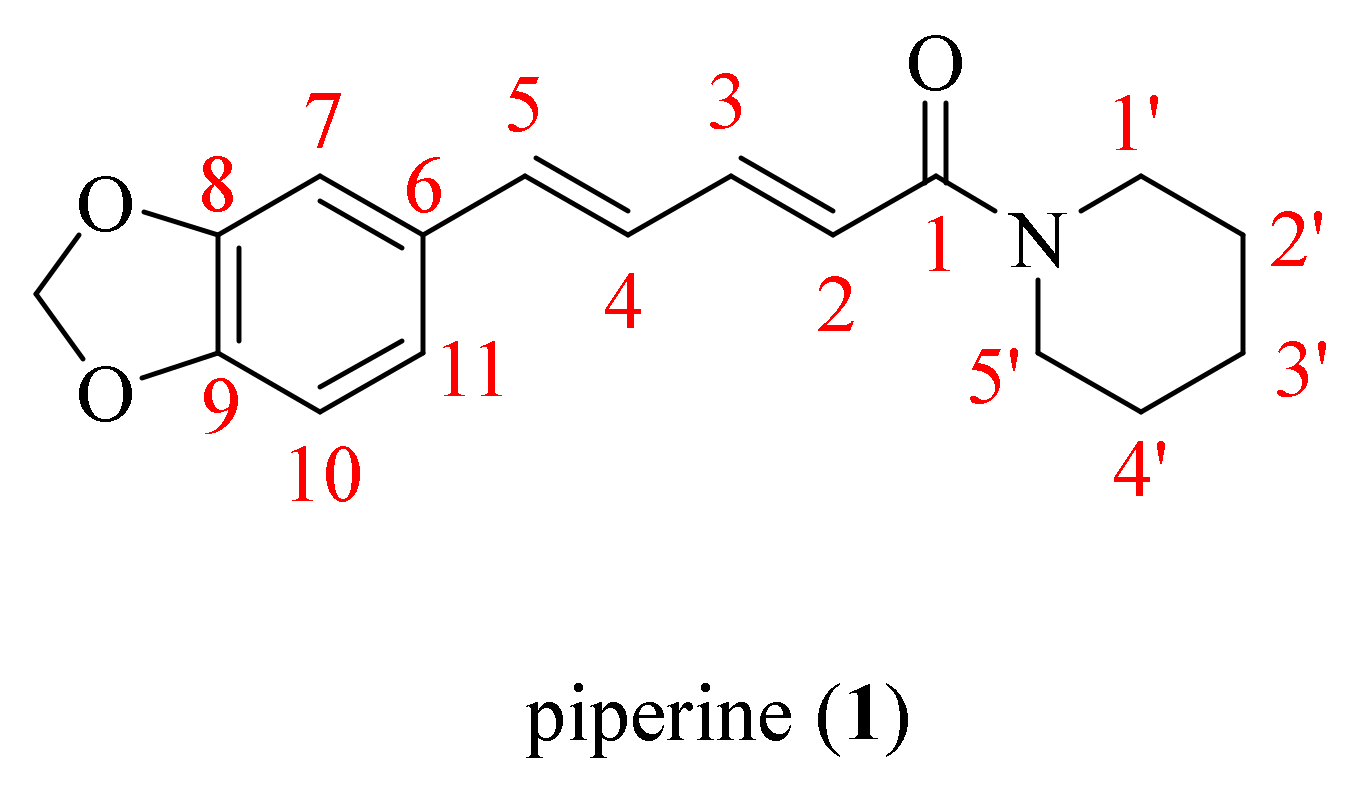

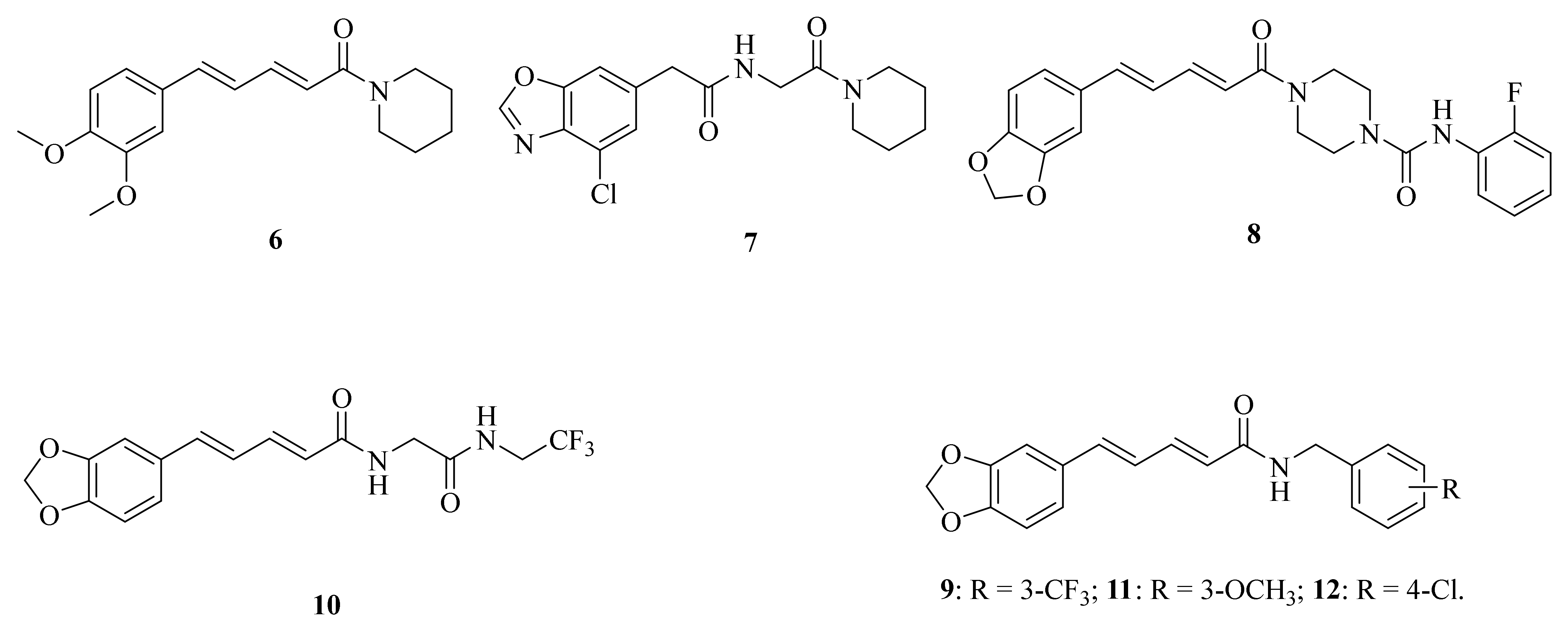

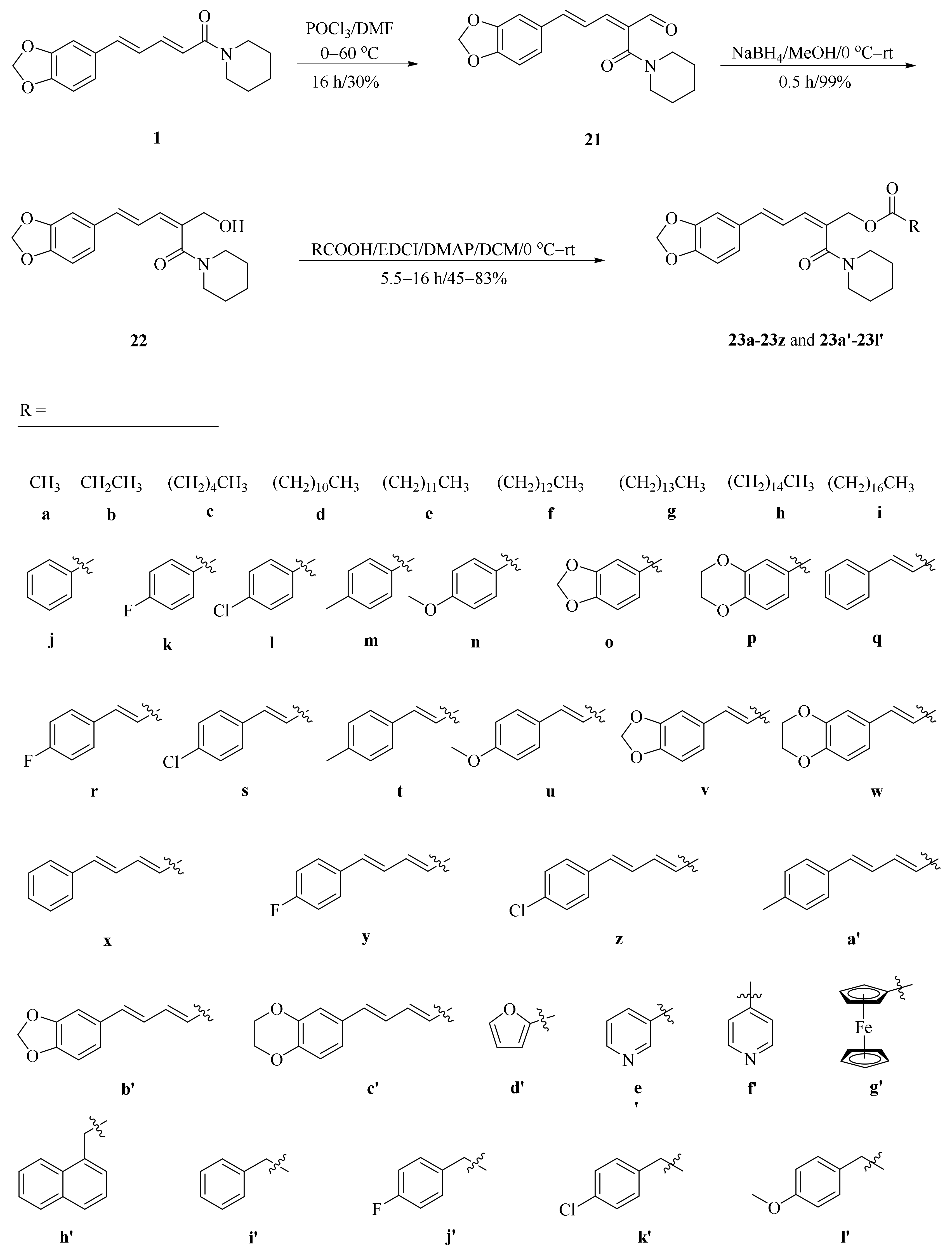
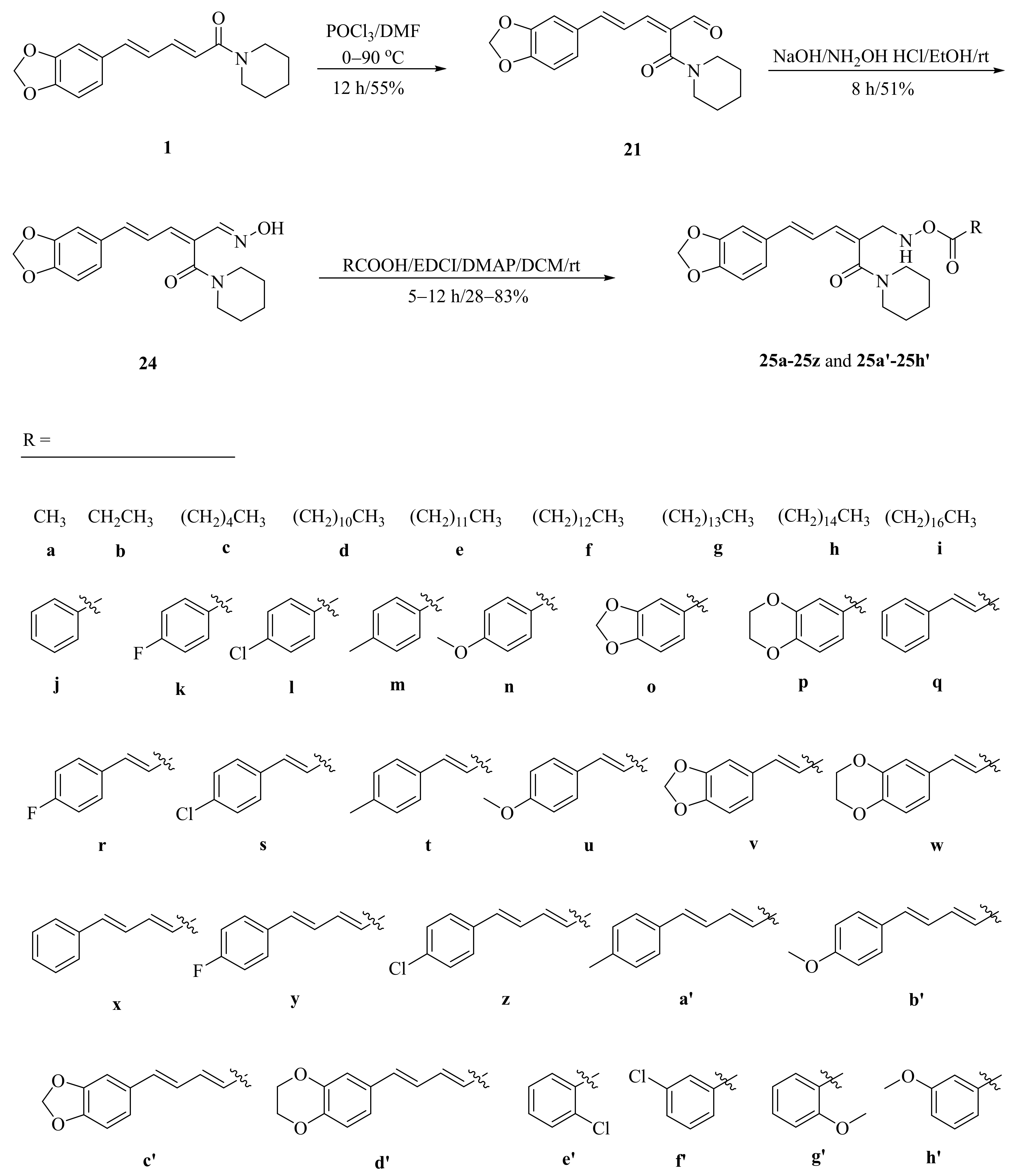
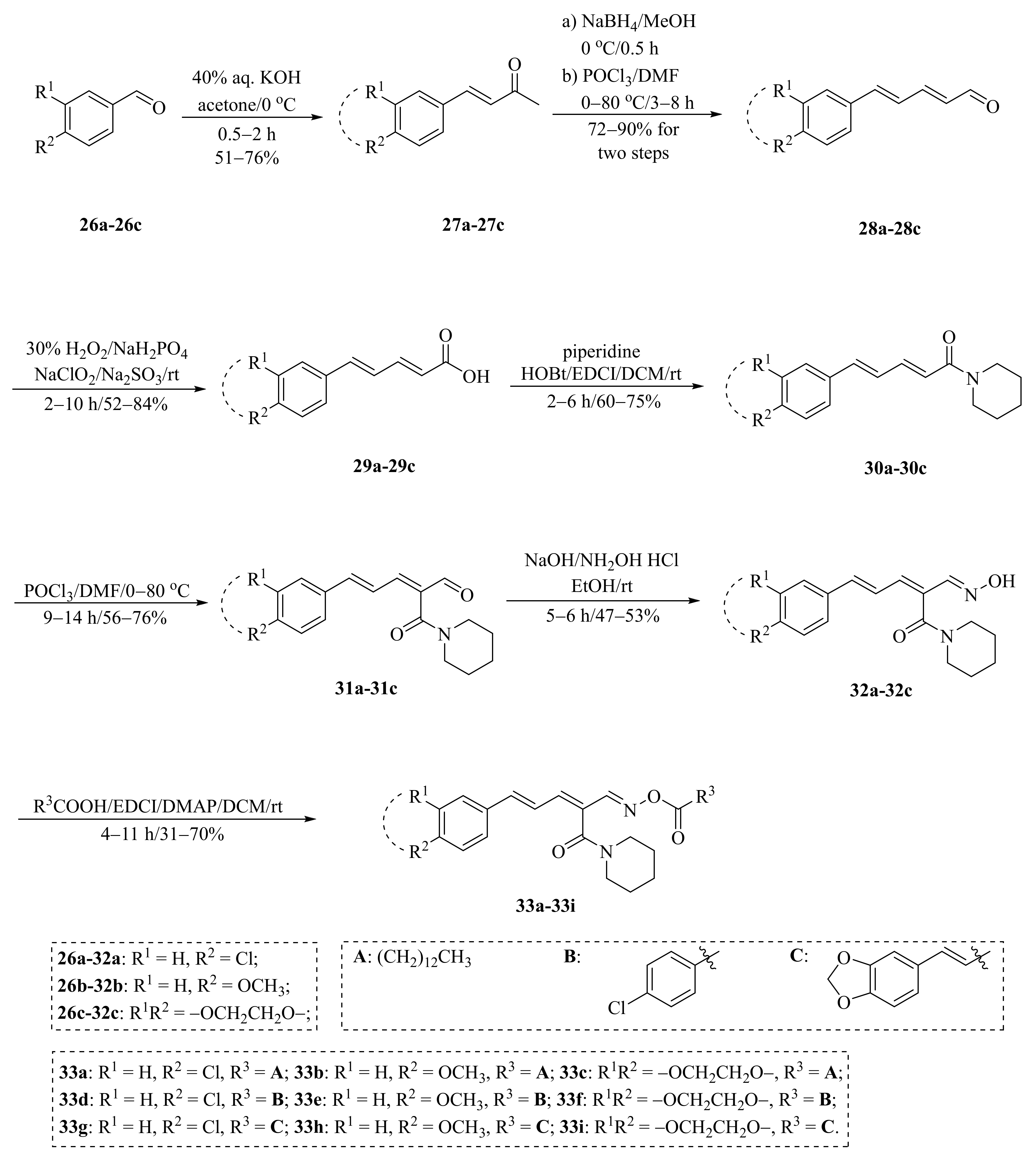

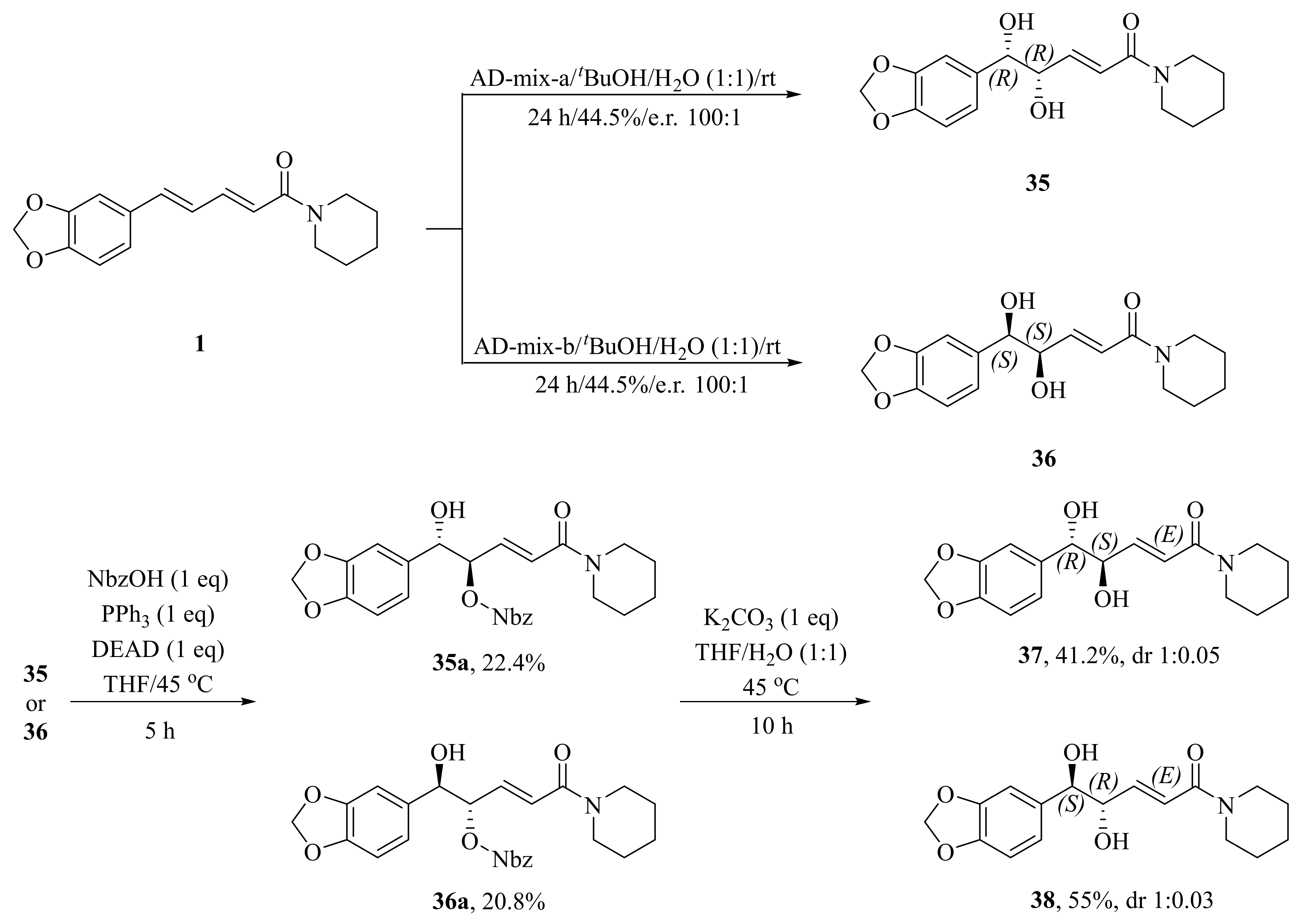

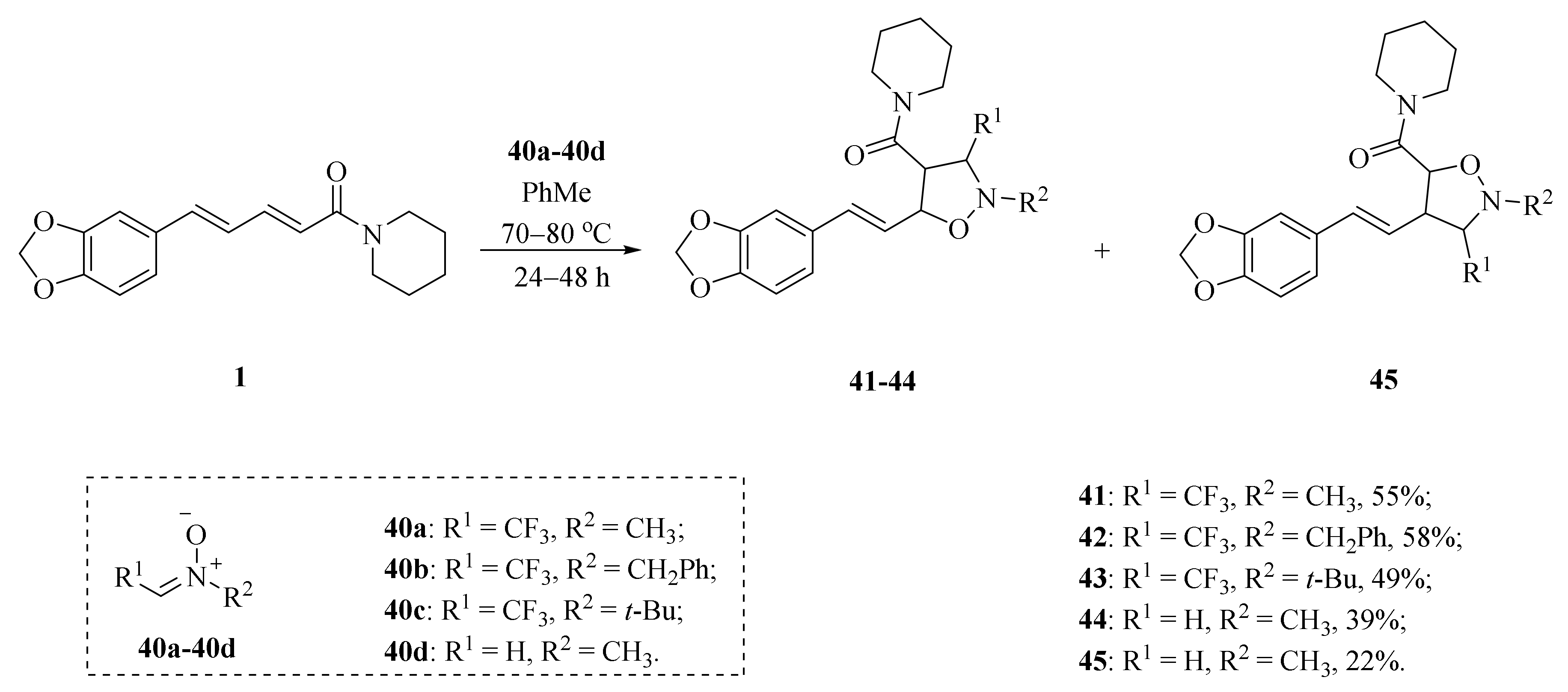
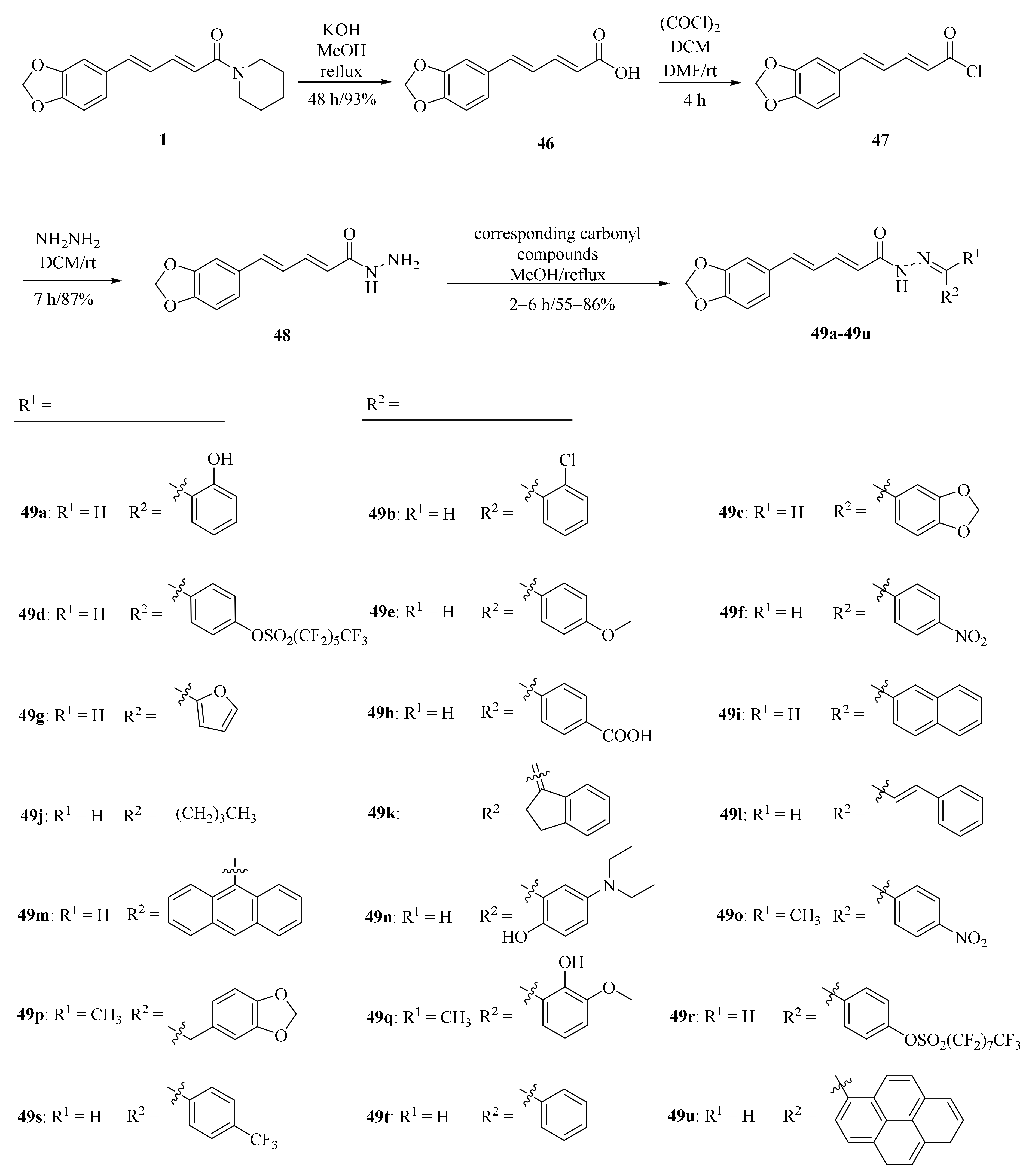
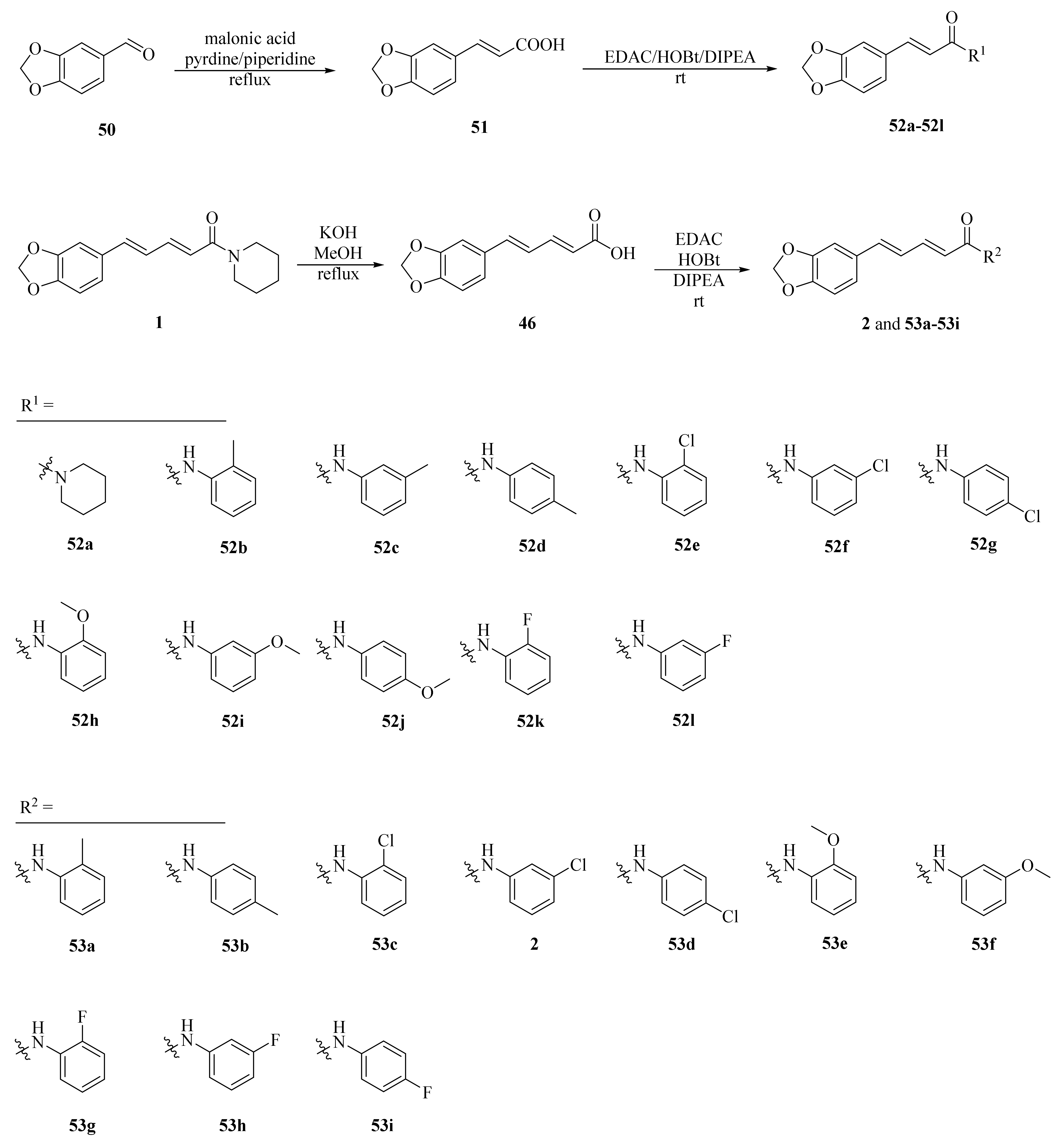
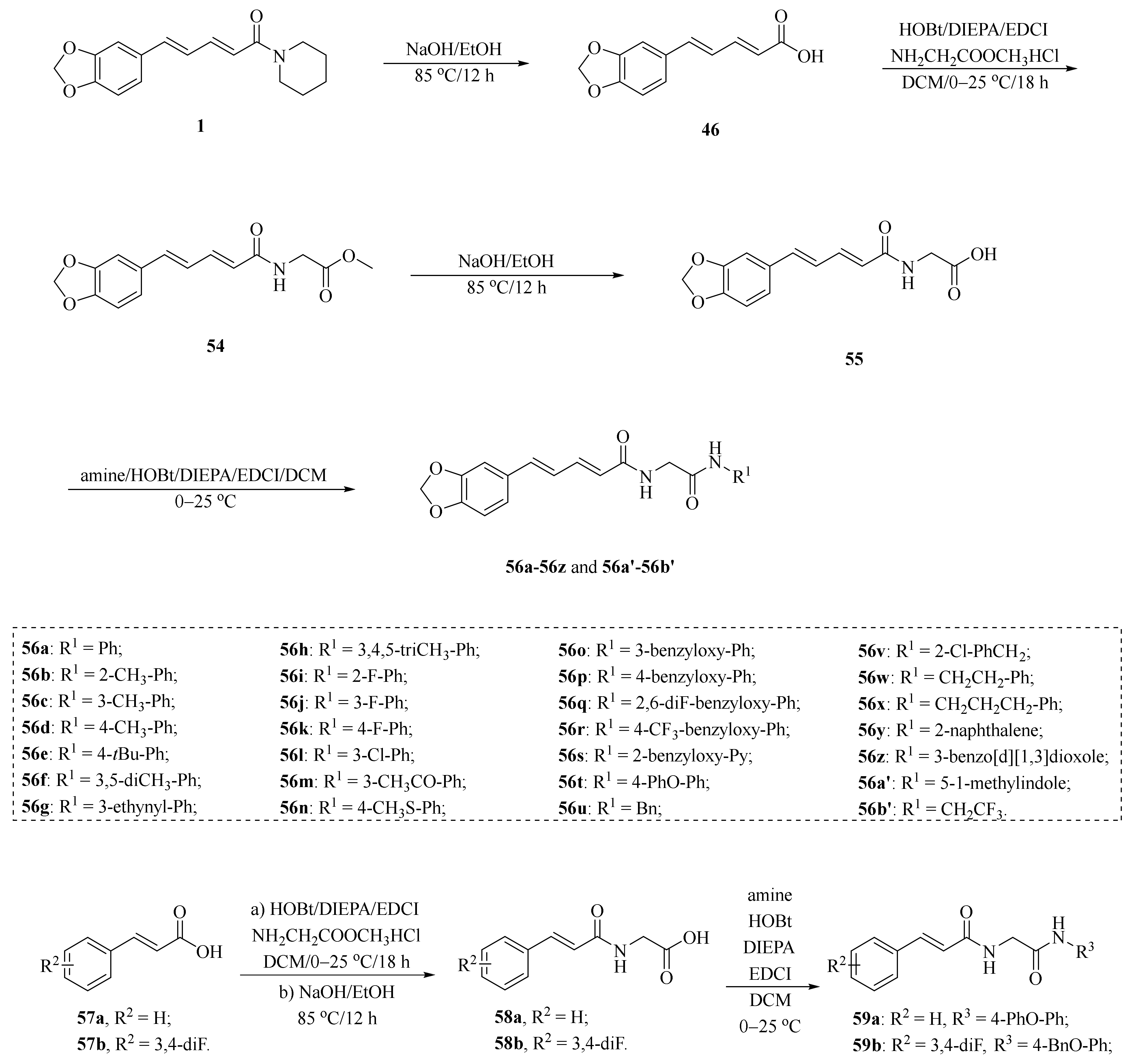

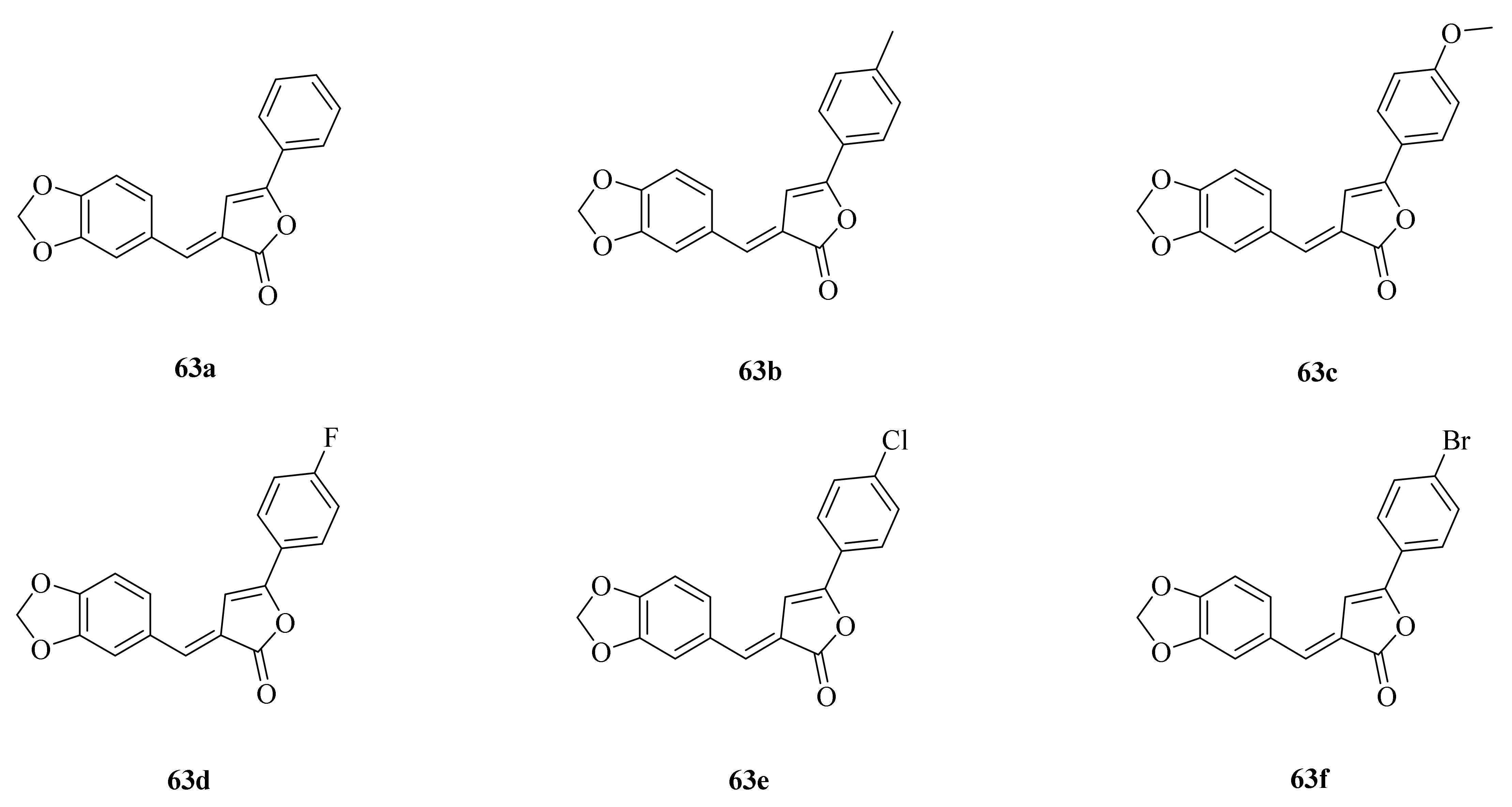
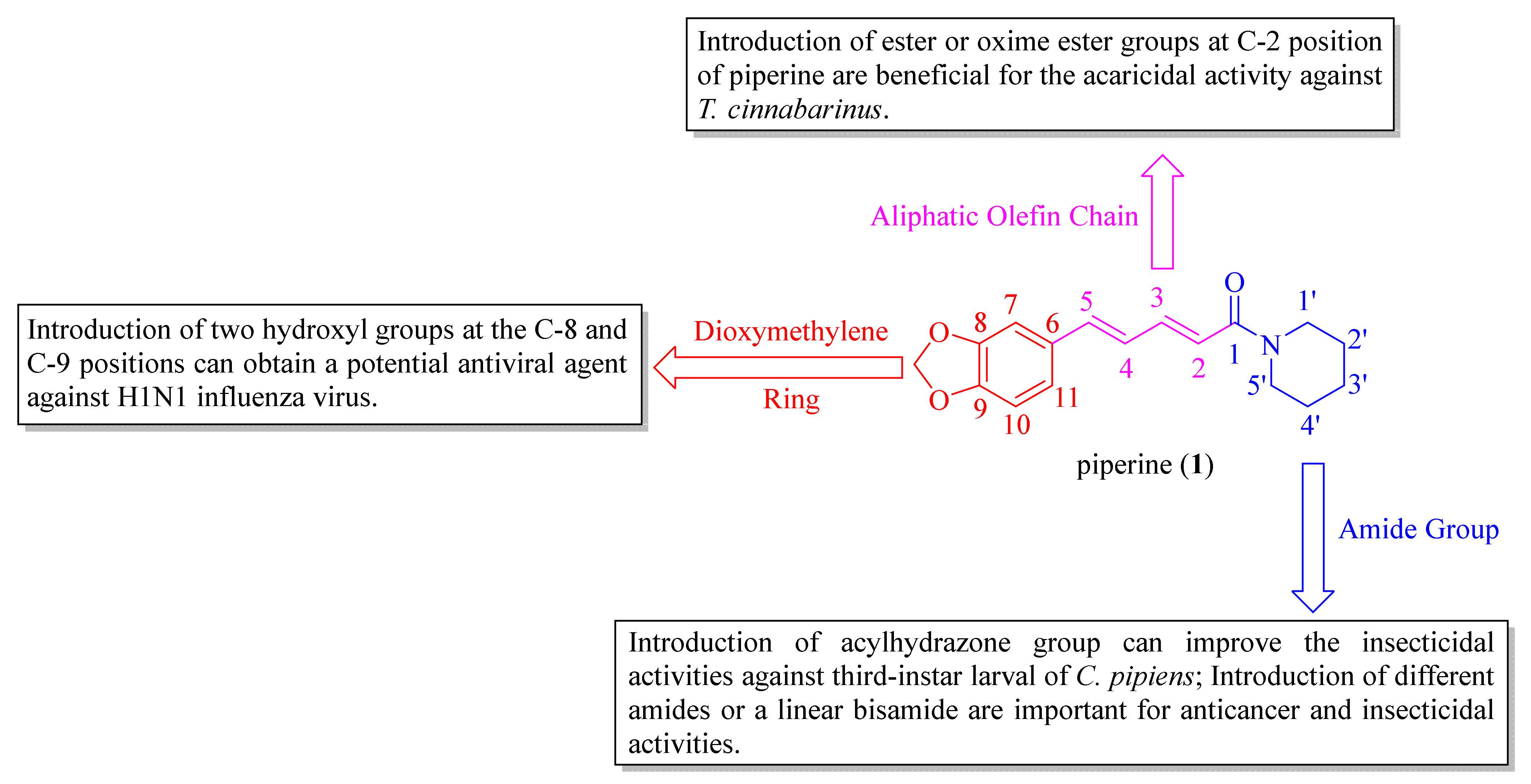
| Compound | LC50 (mg/mL) |
|---|---|
| 1 | 14.20 [29] |
| 23e | 0.16 [29] |
| 23f | 0.12 [29] |
| 23u | 0.18 [29] |
| 23v | 0.16 [29] |
| 25f | 0.14 [28] |
| 25l | 0.16 [28] |
| 25u | 0.19 [28] |
| 25v | 0.13 [28] |
| spirodiclofen a | 0.12 [29] |
| Compound | LC50 (mg/mL) |
|---|---|
| 1 | 0.357 |
| 46 | 0.398 |
| 48 | 0.421 |
| 49a | 0.139 |
| 49b | 0.216 |
| 49f | 0.146 |
| 49g | 0.153 |
| 49m | 0.221 |
| 49n | 0.094 |
| 49o | 0.209 |
| 49p | 0.128 |
| 49u | 0.174 |
| deltamethrin a | 1.457 |
| Compound | Inhibitory Activity (μM) |
|---|---|
| 1 | 0.44 ± 0.05 |
| 62a | 4.72 ± 0.73 |
| 62b | 1.58 ± 0.22 |
| 62c | 9.33 ± 1.06 |
| 62d | 11.98 ± 1.35 |
| 62e | 4.66 ± 0.56 |
| 62f | 2.25 ± 0.56 |
| 62g | 0.75 ± 0.08 |
| 62h | 1.24 ± 0.45 |
| 62i | 11.81 ± 1.47 |
| 62j | 0.04 ± 0.01 |
| 62k | 0.05 ± 0.01 |
Disclaimer/Publisher’s Note: The statements, opinions and data contained in all publications are solely those of the individual author(s) and contributor(s) and not of MDPI and/or the editor(s). MDPI and/or the editor(s) disclaim responsibility for any injury to people or property resulting from any ideas, methods, instructions or products referred to in the content. |
© 2023 by the authors. Licensee MDPI, Basel, Switzerland. This article is an open access article distributed under the terms and conditions of the Creative Commons Attribution (CC BY) license (https://creativecommons.org/licenses/by/4.0/).
Share and Cite
Han, J.; Zhang, S.; He, J.; Li, T. Piperine: Chemistry and Biology. Toxins 2023, 15, 696. https://doi.org/10.3390/toxins15120696
Han J, Zhang S, He J, Li T. Piperine: Chemistry and Biology. Toxins. 2023; 15(12):696. https://doi.org/10.3390/toxins15120696
Chicago/Turabian StyleHan, Jin, Shaoyong Zhang, Jun He, and Tianze Li. 2023. "Piperine: Chemistry and Biology" Toxins 15, no. 12: 696. https://doi.org/10.3390/toxins15120696
APA StyleHan, J., Zhang, S., He, J., & Li, T. (2023). Piperine: Chemistry and Biology. Toxins, 15(12), 696. https://doi.org/10.3390/toxins15120696




